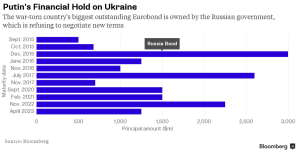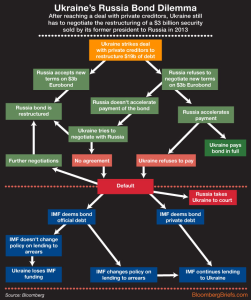If you thought Ukraine’s five-month debt-restructuring battle with Franklin Templeton was tough, just wait until the country starts negotiating with its second-biggest creditor, Russia.
There’s a $3 billion Eurobond due in December that former President Viktor Yanukovych sold to Russia shortly before his ouster in February 2014 and Vladimir Putin’s annexation of Crimea a month later.

Paying this bond in full is “not an option” and Ukraine wants Russia to accept the same terms as other creditors, Finance Minister Natalie Jaresko said in an interview conducted hours before the country on Thursday revealed its main bondholders agreed to a 20 percent principal writedown.
Her peer in Moscow, Anton Siluanov, swiftly knocked down the offer, saying Russia won’t take part and will demand Ukraine pay back the entire sum. The country deems itself an official rather than a commercial creditor, according to the minister, who added Russia will invest the $3 billion in infrastructure.
Where negotiations go from here is likely to be guided by the International Monetary Fund, which has yet to decide how to categorize the bond, and with which Ukraine is engaged on a $40 billion bailout. The situation is further complicated by strained diplomatic relations with Russia, which Ukraine accuses of supporting a smoldering insurgency in its easternmost regions.
Below are three scenarios Ukraine faces with the bond and the reasons they may or may not work:
- Scenario 1: Pay Up
Ukraine may have no choice but to pay the bond in full or risk losing its bailout should the IMF decide it’s official debt. IMF policy dictates it won’t lend to countries that are in arrears on such obligations, while missing payments to private creditors doesn’t exclude it from maintaining a program.
The preliminary view by staff at the crisis lender is that the bond should be classified as official debt, a person familiar with the matter told Bloomberg in June. A final decision will be taken by the IMF’s executive board, which will discuss the matter only when Ukraine is in arrears to Russia, according to Nikolay Gueorguiev, the IMF Mission Chief to Ukraine.
The biggest reason not to take that route might be that handing over such a sum to Russia would be “politically unacceptable” for Ukrainian President Petro Poroshenko, according to Christopher Granville, managing director of research group Trusted Sources in London. The country’s leader is already struggling to win over public support.
Paying the bond would also deplete Ukraine’s already scarce international reserves and put an IMF savings target at risk. The fund has asked Ukraine to make $15.3 billion of savings in public-sector financing in the next four years.
- Scenario 2: Restructure
Ukraine could pursue restructuring without the risk of losing its bailout if the IMF decides the bond is private-sector debt.
Even if the IMF decides it’s official debt, the fund could change its policy on lending regarding arrears, according to former IMF Executive Board member Douglas Rediker. The issue was raised in a 2013 paper that said the IMF was considering extending the policy that allows lending to governments in arrears to the private sector to include official debt.
The downside to this scenario is that Russia is unlikely to accept, having repeatedly said since the beginning of the year that the bond isn’t private debt. The Finance Ministry in Moscow said in March that while the notes took the form of a tradeable Eurobond, it wasn’t issued at the same market conditions. The bond, which was offered to Ukraine as part of a $15 billion loan after it pulled out of a trade pact with the European Union, was sold at a 5 percent coupon, compared with a yield at the time of about 12 percent on 2017 debt. Ukrainian President Petro Poroshenko has described the bond as a “bribe.”
- Scenario 3: Default
Ukraine may prefer to default if it can be sure the IMF will continue lending. If Ukraine withheld payment, it would have a 10-day grace period, meaning it would be in default on Dec. 30. Russia also has the option of demanding early repayment since Ukraine’s public debt has exceeded 60 percent of gross domestic product, violating the terms of the loan.
The potential blowback from such a move includes a Russian lawsuit, something that Finance Minister Anton Siluanov threatened in June before an interest payment was made. That would probably lead to a showdown in British courts as the bond is governed by English law.
Refusal to pay could also further strain Ukraine’s relations with Russia at a time when it is trying to maintain a fragile cease-fire in its east and negotiate new pricing for gas supplies.
For a larger image of the flowchart below, click here

Source




Recent Comments
Adam in: Hruszowice to dopiero początek
wikipedia: "Ukraińska Powstańcza Armia (UPA) jest współodpowiedzialna ...
Adam in: Hruszowice to dopiero początek
chryj, czy jak ci tam ukrze, czytając twoje wypowiedzi można tylko żał ...
Adam in: Hruszowice to dopiero początek
a banderowskie ścierwo wieszało się za jaja na drzewach :) ...
Adam in: Hruszowice to dopiero początek
jak na razie to ukry dostają po dupie - tak jak zawsze :) ...
Adam in: Hruszowice to dopiero początek
rozdeptanie banderowca to nie zbrodnia :) ...